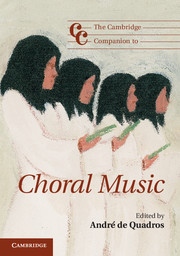Book contents
- Frontmatter
- 1 Introduction: choral music – a dynamic global genre
- Part I Choral music: history and context
- Part II Choral music the world over
- Part III Choral philosophy, practice, and pedagogy
- 15 Globalization, multiculturalism, and the children's chorus
- 16 Exploring the universal voice
- 17 Authentic choral music experience as “good work”: the practice of engaged musicianship
- 18 The making of a choir: individuality and consensus in choral singing
- 19 A point of departure for rehearsal preparation and planning
- 20 Small ensemble rehearsal techniques for choirs of all sizes
- Notes
- Select bibliography
- Index
- Cambridge Companions to Music
15 - Globalization, multiculturalism, and the children's chorus
from Part III - Choral philosophy, practice, and pedagogy
Published online by Cambridge University Press: 28 September 2012
- Frontmatter
- 1 Introduction: choral music – a dynamic global genre
- Part I Choral music: history and context
- Part II Choral music the world over
- Part III Choral philosophy, practice, and pedagogy
- 15 Globalization, multiculturalism, and the children's chorus
- 16 Exploring the universal voice
- 17 Authentic choral music experience as “good work”: the practice of engaged musicianship
- 18 The making of a choir: individuality and consensus in choral singing
- 19 A point of departure for rehearsal preparation and planning
- 20 Small ensemble rehearsal techniques for choirs of all sizes
- Notes
- Select bibliography
- Index
- Cambridge Companions to Music
Summary
Choruses are transforming. In many parts of the world, new communities create new vocal ensembles to reflect their own identities and passions. As populations shift, and communities expand to include a diverse range of people, choirs seek to span conventionally unbridgeable borders such as rich–poor, East–West, North–South, or Christian–Muslim. Likewise, concert audiences are changing, and increasingly demand repertoire that is relevant to their respective cultures and experiences. The younger generations, which have grown up in the digital age and with globalization, also seem to be more open and receptive to different cultures than some of the older generations.
In this chapter, I will focus on the children's chorus and its future in an increasingly globalized society. This discussion will be based on my artistic and social philosophy – one that has been strengthened by personal experience as founder and conductor of the Young People's Chorus of New York City (YPC), an organization which began as an after-school program and is designed to thrive in a diverse, but still largely segregated city. In this environment, I learned a great deal from the children as I observed how they changed both socially and musically, and how they learned to interact comfortably with peers from diverse backgrounds. I will also examine the state of the youth chorus today, its place in the community, and the challenges it faces in organization, advocacy, and audience development. I will argue that choruses should strive for both artistic excellence and diversity: the dual mission that has propelled me to question the relevance of the children’s chorus in a global community – one that is faced with ever-changing attitudes, new trends and audiences, and many opportunities for non-traditional avenues for performance and outreach.
- Type
- Chapter
- Information
- The Cambridge Companion to Choral Music , pp. 201 - 215Publisher: Cambridge University PressPrint publication year: 2012
- 1
- Cited by



